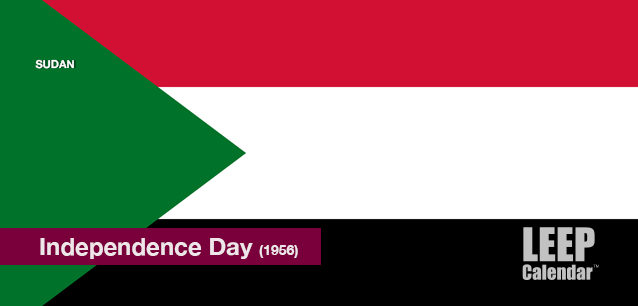 AD
AD
Today is: December 21
Scroll to explore events active on this date.
Additional Events on LEEP
LEEP INK FEATURES

August? Absolutely!
In August, we live through the Dog Days of Summer. It's hot and often humid, and those who can leave for better climates do. Down south, winter is in full force. August is also known as "the ...

In The Heat of July: July 2025 Events
Is it hot enough (or cold enough if you're below the equator) for you yet? There is actually a day for that! Like every month, I pick a diverse collection of events you may or may not know about. This ...

May Blooms: Events in May 2025
Along with October, May is one of the most densely packed months of the year. It's before the summer humidity and the last whole month of the school year. The weather is warming in t...
About Independence Day in Sudan
Civil Rights , Africa
Ends: Jan 01, 2025
DESCRIPTION:
INDEPENDENCE DAY IN SUDAN
Sudan’s Independence Day, celebrated annually on January 1, marks the day in 1956 when the country officially gained its sovereignty from British and Egyptian rule. The historic event came after decades of colonial administration and a growing nationalist movement that sought to unite Sudan's diverse population under an independent government.
The roots of Sudan's independence can be traced back to the late 19th and early 20th centuries. After the fall of the Mahdist State in 1898, Sudan became a condominium governed jointly by Britain and Egypt. Despite this dual authority, Britain held the dominant role in the administration of the territory. The colonial government implemented policies that emphasized regional and ethnic divisions, particularly between the northern and southern parts of the country.By the 1940s, Sudanese leaders began to organize politically, advocating for greater autonomy and eventual independence.
The formation of political parties such as the Umma Party and the National Unionist Party (NUP) reflected the growing desire for self-rule. These movements gained momentum after World War II, as global decolonization efforts inspired Sudanese activists.Negotiations for independence began in earnest in the early 1950s, culminating in an agreement for self-determination. In December 1955, the Sudanese parliament unanimously passed a resolution declaring independence.
On January 1, 1956, the Republic of Sudan was formally established, and the Sudanese flag was raised in Khartoum, replacing the Union Jack.The first years of independence were marked by challenges, including managing the country's vast ethnic and cultural diversity and addressing inequalities between the north and south. These issues would later contribute to prolonged periods of civil conflict.
Nevertheless, Sudanese Independence Day remains a symbol of national pride and a testament to the resilience and determination of its people.Each year, the day is commemorated with parades, cultural performances, and public gatherings, celebrating the rich heritage of Sudan and its journey to self-rule. It serves as both a reflection of the country’s historical struggles and a reminder of the ongoing efforts to build unity and progress.
VIDEOS
Currently, this event does not have supporting videos.
SUPPORTING DOCUMENTS
Currently, this event does not have supporting documents.
ADDITIONAL IMAGES
Currently, this event does not have supporting images.
Where would you like to go now?
 AD
AD


/footer-logo.svg)
